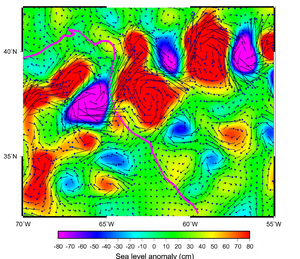Biology
Life in the ocean is funtamental to life on Earth. Phytoplankton in particular is major generators for the planet, much more than the forests. Although measuring 'ocean color' by satellite is the best technique for determining the quantity of phytoplankton, sea-surface height measurements complement and validate these data.
The movements of the ocean, its temperature and salinity, ect, affect the life it harbours. From the smallest plant organisms (phytoplankton) to the largest whales, not forgetting animals such fishes and marine turtles, all are affected by the physical conditions of their environment.
Developping marine ecosystem models with the available biological and physical information as input, will help us better understand marine biology and therefore preserve its resources and diversity.
Further information:
- Altimetry applications in videos: Life in the ocean, Fishing management.
- Aviso Newsletter #9: Argonautica: "20,000 schools over the sea", P. Canceill and al. (pdf, 520 Ko).





